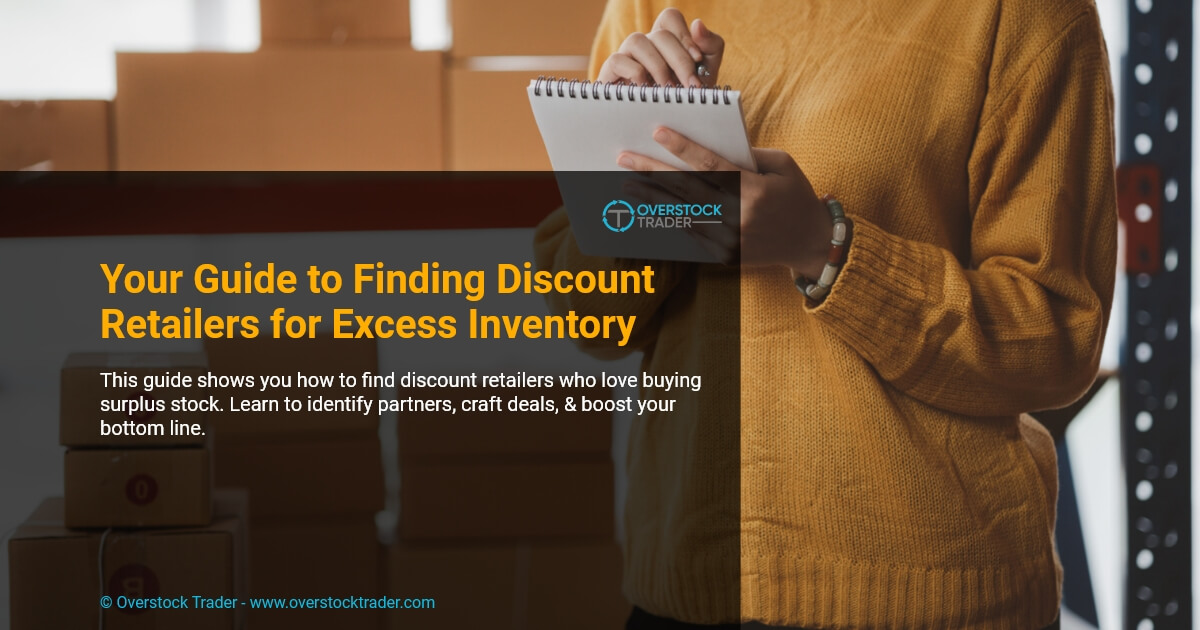For businesses, excess inventory can be a major thorn in the side. It not only locks up valuable capital and requires precious storage space, but it can also lead to significant financial losses if left unmanaged. Finding buyers for this surplus stock is crucial to recouping costs, freeing up resources, and paving the way toward increased profitability. This guide outlines the essential steps and best practices to help you connect with discount retailers and transform your excess inventory into revenue.
The steps outlined below closely mirror our own proven process for helping clients achieve successful liquidation and sale of excess inventory.
Step 1: Identify Your Target Market for Excess Inventory
Before you start searching for buyers, it’s essential to identify your target market. Consider the following factors:
Industry
Which retailers or sectors might benefit from your excess inventory? Are there complementary industries that could utilize your surplus inventory?
Geographic location
Focus your initial search on nearby buyers to minimize transportation costs. However, be prepared to expand your reach nationally or internationally if necessary. Remember, the further the buyer, the higher the freight costs, impacting your final sales price.
B2B or B2C
Decide whether selling to other businesses (B2B) or directly to consumers (B2C) aligns better with your goals and the nature of your excess inventory.
Online or offline
Should you prioritize online platforms, offline sales, or a combination of both to reach your target audience effectively? This depends on your product type and target market preferences.
Types of Excess Inventory Buyers

It’s crucial to determine which types of buyers you want to sell your inventory to. Companies that buy excess inventory typically fall into several categories, each with its specialization and focus. The types of companies that purchase surplus stock include:
Liquidation Companies
Inventory Liquidation Companies specialists purchase excess inventory from various businesses, including manufacturers, wholesalers, and retailers. They typically buy large quantities and resell them through their established networks, reaching discount retailers, off-price retailers, online sellers, and smaller businesses.
Wholesalers and Distributors
These businesses often purchase excess inventory to supply their retail customers. Their bulk buying power and distribution networks ensure efficient movement of surplus stock.
Discount Retailers
Stores specializing in discounted and clearance merchandise frequently buy excess inventory to stock their shelves. Think outlet stores and discount chains.
Online Retailers
E-commerce platforms and marketplaces offer opportunities for various companies, from small sellers to larger retailers, to purchase excess inventory and sell directly to consumers.
Exporters
Exporting companies seek excess inventory to find buyers in international markets interested in those products. This can be a great way to “disappear” large quantities of inventory without impacting your current distribution and pricing strategies.
Surplus Stores
These stores specialize in selling a wide range of excess inventory, including surplus military goods, electronics, clothing, and more. They cater to both consumers and businesses.
Closeout Buyers
These buyers purchase discontinued or end-of-season products from retailers, providing them with a way to clear out inventory and make room for new items.
Leverage Online Marketplaces

The meteoric rise of online marketplaces has revolutionized distribution, and their impact on the excess inventory landscape is undeniable. These platforms offer a powerful tool for sellers to connect with potential buyers quickly and efficiently, facilitating transactions across borders and industries. Let’s dive into some of the most popular options:
eBay
This global giant reigns supreme for consumer goods and smaller quantities. Its vast user base and diverse product categories make it ideal for reaching a broad audience. eBay’s easy-to-use interface and established auction system provide a familiar and user-friendly experience for both sellers and buyers.
Amazon
A powerhouse in both B2B and B2C sales, Amazon excels when it comes to new or branded items. Its reputation for quality and fast delivery attracts a loyal customer base, making it an excellent platform to reach consumers seeking specific products. Amazon also offers a dedicated B2B portal, Amazon Business, catering specifically to bulk purchases and wholesale transactions.
Alibaba
For sellers with large quantities of excess inventory, Alibaba opens doors to a vast international audience. This Chinese e-commerce giant connects businesses worldwide, making it a valuable resource for reaching potential buyers beyond domestic borders. Alibaba’s diverse product categories and focus on wholesale transactions make it ideal for bulk liquidation efforts.
B2B Marketplaces
For sellers targeting businesses seeking bulk purchases, B2B marketplaces like Thomasnet, Global Sources, etc. offer a specialized platform. These websites cater specifically to business-to-business transactions, connecting suppliers with buyers across various industries. Their extensive directory allows for targeted marketing efforts and efficient negotiation of wholesale deals.
Liquidation Marketplaces
Sellers seeking to offload large quantities of excess inventory quickly can find a convenient and efficient solution with liquidation marketplaces. Platforms like Overstock Trader, B-Stock, Liquidation.com, and Direct Liquidation specialize in surplus and returned merchandise, offering these items at discounted rates to attract buyers seeking deals. Additionally, Overstock Trader offers a unique platform specifically dedicated to connecting sellers with a network of established retail outlets seeking to purchase excess inventory, providing an efficient and targeted solution for specific types of surplus stock.
Social Media
Don’t underestimate the power of social media platforms like LinkedIn and Facebook. These networks provide excellent opportunities to connect with potential buyers and industry groups. Utilize social media to share information about your excess inventory, announce upcoming liquidation sales, and build relationships with potential partners. Engaging with industry groups and participating in relevant discussions can also attract interested buyers to your surplus stock.
Step 2: Research Potential Buyers for Your Excess Inventory

Following our exploration of potential avenues for selling your excess inventory, let’s delve deeper into identifying companies interested in purchasing your surplus goods. In today’s business landscape, research plays a crucial role in uncovering sales prospects and crafting an effective sales strategy.
Step-by-Step Guide to Research and Identifying Potential Inventory Buyers
Leverage Your Existing Network
Don’t overlook the value of your network. Connect with businesses within your industry, attend trade shows, and participate in networking events to forge relationships with potential buyers. Consider offering your surplus stock to past customers who might be interested in acquiring them at a discounted price.
Use Industry-specific Websites
Explore industry-specific websites, forums, and publications relevant to your product or service. These platforms often offer valuable resources, including company listings, industry news, and insights into your target market’s challenges and opportunities.
Conduct Competitor Analysis
Analyze your competitors’ business practices, including the companies they partner with. Consider if these companies could also be potential clients for your surplus inventory. Tools like SEMrush and Ahrefs can assist you in analyzing competitor websites and backlinks, providing valuable insights into their target audience and marketing strategies.
Trade Shows and Conferences
Industry-specific events present excellent opportunities to network with potential buyers face-to-face. Collect business cards and actively engage with attendees to learn about their companies and explore potential partnerships.
Google Search and Industry Reports
Conduct Google searches using relevant keywords related to your product or service. Look for industry reports, market analyses, and news articles that mention potential target companies. Google Alerts can help you stay updated on relevant news.
Chamber of Commerce and Business Associations
Check with local and regional chambers of commerce and industry-specific business associations. These organizations often maintain directories of businesses within their area of influence, facilitating networking opportunities and access to valuable resources.
Company Websites
Visit the websites of potential target companies. Look for “Contact Us” or “About Us” pages, which often provide information about key decision-makers, contact details, and the company’s mission and values.
Take action today! Start your research, refine your inventory presentation, and connect with potential buyers. The rewards of successful excess inventory liquidation await.
Want to know the value of your inventory?
Step 3: Compile a Detailed Inventory List

Identifying your target buyers and specific companies opens the door to the next crucial step – creating a detailed product manifest. This comprehensive document forms the foundation for effective sales efforts and plays a vital role in attracting buyers and maximizing your return on excess inventory.
Overstock Trader Sample Inventory Manifest
Essential Components of a Detailed Inventory List
Product Descriptions
Provide clear and concise descriptions of each item, including its name, brand, model/SKU number, size, color, and any unique features or specifications.
Precise Quantities
Clearly state the number of units available for each item. This allows buyers to assess if your inventory aligns with their requirements and plan their purchases accordingly.
Honest Assessment of Condition
Be transparent about the condition of each item, using terms like “new,” “like new,” “refurbished,” “open-box,” “used,” or “damaged.” Specify any wear and tear or cosmetic imperfections to manage buyer expectations and prevent future disputes.
Competitive Pricing Information
Set competitive prices for your excess inventory. Research market prices for similar products to ensure your pricing is competitive. If you’re open to negotiation or offering discounts for bulk purchases, clearly state that in your inventory list. Providing a unit price and total cost for each item or product lot can be helpful.
High-Quality Visuals
A picture is worth a thousand words. Include high-resolution photos of your inventory items. Multiple angles, close-ups of any defects (if applicable), and images showing the product’s packaging can give potential buyers a better understanding of what they are considering purchasing. Well-lit, clear photos can significantly increase buyer interest.
Additional Information
Depending on the nature of your excess inventory, consider including additional information such as expiration dates (for perishable goods), manufacturing dates, and any warranty or return policy details. This information can instill confidence in buyers.
Organized and Accessible Format
Present your inventory list in an organized and easily readable format. You can use spreadsheet software or specialized inventory management tools to create a structured list. Group similar items together, and if you have multiple product categories, consider creating sections or tabs for each category.
Regular Updates
Keep your inventory list up to date. As items are sold or new inventory becomes available, promptly make changes to your list. Outdated information can lead to confusion and frustration for potential buyers.
Step 4: Engage Potential Buyers: Effective Outreach Strategies

With your target outlets identified and a comprehensive inventory list prepared, the exciting stage of buyer outreach begins. Explore these effective methods to connect with potential buyers and convert your excess stock into valuable revenue.
Cold Calling
While often perceived as intimidating, cold calling remains a powerful tool for outreach when done strategically. Here are some tips to maximize your success:
Thorough Research
Before dialing, invest time in understanding the prospective buyer’s business. Identify their needs and how your inventory can address them, crafting a compelling pitch tailored to their specific challenges.
Compelling Pitch
Develop a concise and engaging introduction that highlights the value proposition of your inventory. Address the prospect’s needs and pain points early on, capturing their immediate attention.
Respectful Interaction
Remember, buyers are busy individuals. Be mindful of their time, inquire about their availability, and be prepared to adapt your schedule if necessary.
Active Listening
Effective cold calling involves not just speaking, but also actively listening. Pay close attention to the prospect’s needs and concerns, adapting your pitch to address them directly.
Follow-up
Persistence is key. If your initial call doesn’t connect, leave a professional voicemail or send a follow-up email expressing your continued interest.
Email Outreach
Email remains a versatile and cost-effective method for reaching buyers. To stand out in crowded inboxes, follow these best practices:
Personalized Messages
Avoid generic templates. Start with a personalized greeting and tailor your email content to the recipient’s specific needs and challenges. This demonstrates genuine interest and increases engagement.
Compelling Subject Lines
Craft attention-grabbing subject lines that pique curiosity or address a pain point. This encourages the recipient to open your email and learn more about your offerings.
Clarity and Concision
Keep your email concise and to the point. Highlight the benefits of your excess inventory and include a clear call to action, prompting the recipient to take the desired next step.
Value-Added Content
Offer valuable content beyond just your product or service. Include whitepapers, case studies, industry insights, or helpful tips. This positions you as a knowledgeable resource and establishes trust with potential buyers.
A/B Testing
Experiment with different email formats, subject lines, and content to determine what resonates best with your target audience. Data-driven optimization helps you refine your approach for maximum effectiveness.
Leveraging LinkedIn
LinkedIn offers a valuable platform for connecting with potential buyers, and at Overstock Trader, we utilize it extensively. Here’s how to maximize your reach:
Optimized Profile
Ensure your LinkedIn profile is professional and up-to-date. Highlight your expertise, industry knowledge, and past achievements. A strong profile attracts potential buyers and encourages them to connect.
Strategic Connections
Focus on connecting with potential buyers and decision-makers within your target market. Don’t simply request connections; personalize your connection requests with a brief message outlining your interest and expertise.
Engaging in Groups
Join relevant LinkedIn groups and actively participate in discussions. Share insights, contribute valuable content, and establish yourself as a thought leader in your industry. This builds trust and increases your visibility to potential buyers.
Content Sharing
Regularly share valuable content such as articles, infographics, and videos that demonstrate your knowledge and expertise. This attracts the attention of potential buyers and positions you as a trusted resource within your field.
Direct Messaging
Utilize LinkedIn’s messaging feature to connect directly with potential buyers. Keep your messages respectful, concise, and focused on providing value. Offer solutions to their specific needs and challenges to foster engagement and encourage further discussions.
Step 5: Evaluate Offers and Negotiate Winning Deals

Congratulations, you’ve successfully connected with potential buyers, showcased your excess inventory, and secured initial offers! Now comes the crucial stage of reviewing these proposals and navigating the intricate dance of negotiation. This phase holds immense significance in determining the fate of your surplus stock, and mastering effective negotiation strategies is paramount.
From Offers to Agreements:
Scrutinize Each Proposal
Carefully examine the terms and conditions of each offer, ensuring alignment with your goals and priorities. Consider factors beyond price, such as payment terms, delivery timelines, and potential hidden clauses.
Building Rapport and Collaboration
Negotiation extends beyond mere price haggling. Focus on fostering a positive relationship with potential buyers, establishing common ground, and collaborating to reach mutually beneficial agreements.
Interpreting Multiple Offers
While securing the ideal price is desirable, receiving multiple offers within a similar range can be a positive indicator. This consistency suggests market recognition of your inventory’s value and offers reassurance even if the final price falls short of your initial expectations.
Negotiation: An Art and a Science
Flexibility and Adaptability
Recognize that achieving desired outcomes may necessitate compromise. Be prepared to adjust your expectations and explore alternative solutions that satisfy everyone involved.
Beyond Price
Negotiation involves more than just haggling over numbers. Consider other factors like payment terms, volume discounts, and bundled offers that can enhance the overall value proposition for both parties.
Learning from Negotiations
Each interaction offers valuable insights. Leverage the knowledge gained during negotiations to inform future inventory management strategies and refine your approach in the ever-evolving landscape of discount sales.
Building Lasting Relationships
Successful negotiations go beyond securing favorable deals
They also pave the way for future collaborations by establishing trust and fostering a sense of cooperation.
Professionalism and Respect
Maintain a professional and respectful demeanor throughout the negotiation process, even in challenging situations. Building positive relationships now lays the groundwork for future partnerships.
Win-Win Strategies
Focus on achieving win-win outcomes where both parties feel satisfied with the final agreement. This fosters a sense of fairness and encourages continued collaboration.
Step 6: Complete the Deal: Reap the Rewards of Excess Inventory Liquidation

Reaching the culmination of this journey – successfully identifying and engaging with discount buyers for your excess inventory – marks a significant achievement. It signifies the effectiveness of your strategy and your business’s resilience in the market. While the selling price may not have reached the initial target, the broader benefits of liquidating excess inventory are substantial.
Beyond the Immediate Profit
The accomplishment lies not just in the monetary gain, but also in the strategic maneuvering that positions your business for future success. Liquidating surplus inventory unlocks a range of benefits, including:
- Freeing Up Valuable Storage Space: Reclaim valuable space for essential inventory and operational activities.
- Boosting Operational Efficiency: Streamline your processes by eliminating the need to manage and store unwanted goods.
- Mitigating Risk: Reduce the risk associated with holding onto aging or seasonal stock that may become obsolete or depreciate.
- Building Relationships: Foster positive relationships with discount buyers, potentially opening doors for future collaborations.
Demonstrating Adaptability and Resourcefulness:
By effectively managing excess inventory and adapting to the dynamic market demands, your business demonstrates:
- Adaptability: The ability to adjust strategies and methods to navigate changing market conditions.
- Resourcefulness: The capacity to find creative solutions to optimize inventory management and maximize return on investment.
A Seamless Process, a Cohesive Strategy
Optimizing the process of finding discount buyers starts with integrating it seamlessly into your overall inventory management strategy. This includes:
- Developing a Well-Thought-Out Inventory Management Plan: This plan should encompass strategies for identifying discount buyers, determining optimal selling prices, and negotiating deals effectively.
- Aligning Your Pricing Strategy with Your Brand: Ensure your pricing negotiations resonate with your overall brand strategy and maintain brand consistency.
Conclusion
The journey to find discount buyers for your unwanted products requires a tailored approach. While the specifics of each scenario may vary, embracing a strategic mindset and adapting your methods to the dynamic demands of the market are crucial.
For those seeking expert assistance, companies like Overstock Trader specialize in facilitating alternative discount distribution channels and can provide valuable guidance throughout the process.
Frequently Asked Questions
Do Marshalls or Ross Stores pay more for overstock inventory?
Each retailer employs its proprietary algorithm to set pricing based on the preferences of their buyers, leading to potential variations in the amounts paid for items. Pricing is also influenced by factors such as current availability and overall brand strategy. There are instances where Marshalls and TJ Maxx might pay more for similar items, while at other times, Ross Stores takes that position.
Who are the category buyers at Ollie’s Bargain Outlet?
Ollie’s Bargain Bin simplifies the process of identifying the appropriate buyer to reach out to and provides their contact information effortlessly. The relevant details can be accessed at their website https://www.ollies.us/contact-us/our-buyers/.
Do Marshalls and TJ Maxx have the same buyers?
Marshalls and TJ Maxx, subsidiaries of TJX Companies, Inc., function as distinct brands but frequently collaborate on resource sharing. Although certain buying functions may be centralized, differences can arise in the buying teams and strategies for each brand, specifically in choosing merchandise that aligns with their distinct target audience and branding. Each brand tailors their product assortment to cater to the specific preferences and expectations of their customers.
How does the role of a category buyer differ from that of a merchandise buyer for off-price retailers?
Category Buyers usually specialize in specific product categories, such as electronics, apparel, home goods, or toys. On the other hand, Merchandise Buyers are tasked with overseeing the comprehensive aspects of product selection, pricing strategies, and inventory management
Does Ross Stores own dd’s DISCOUNTS?
Yes, Ross Stores, Inc. owns DD’s Discounts. Ross Stores is an American chain of off-price department stores, and DD’s Discounts is a subsidiary that operates as an off-price retail chain offering discounted merchandise. Both brands are part of the same parent company, Ross Stores, Inc.
What are the various types of buyers at HomeGoods?
HomeGoods organizes its purchasing responsibilities based on product categories, with distinct buyers overseeing different segments. These may include a Textile and Bedding Buyer, Kitchen and Dining Buyer, Furniture and Rugs Buyer, Seasonal Buyer, and Gifts and Specialty Buyer. For the latest and most precise information, it is recommended to reach out to HomeGoods directly or consult their official website for details regarding careers and specific roles.
Do Dollar General, Dollar Tree, and Family Dollar buy liquidations?
Discount retailers like Dollar General, Dollar Tree, and Family Dollar may engage in buying liquidation merchandise in certain situations. Liquidation involves selling off excess inventory or discontinued items, often at a significantly reduced price. These retailers may consider purchasing liquidated goods to obtain products at a lower cost, which can contribute to their strategy of offering value-oriented pricing to customers.
Are discount retailers and off-price retailers the same thing?
Discount and off-price retailers share the common goal of providing products at lower prices compared to traditional retail stores. However, they differ in inventory management: discount retailers offer a stable inventory with consistent product availability, while off-price retailers feature more variable inventories, leading to unique product discoveries during each visit based on discounted merchandise availability.
What is the difference between Saks off Fifth and Saks Fifth Avenue?
In essence, Saks Fifth Avenue prioritizes delivering a luxurious shopping experience featuring the latest high-end items of the current season. In contrast, Saks Off 5th embraces an off-price model, presenting discounted merchandise from a range of upscale brands. The primary distinctions between them are evident in their inventory makeup, pricing approaches, and the overall shopping atmosphere they offer.

